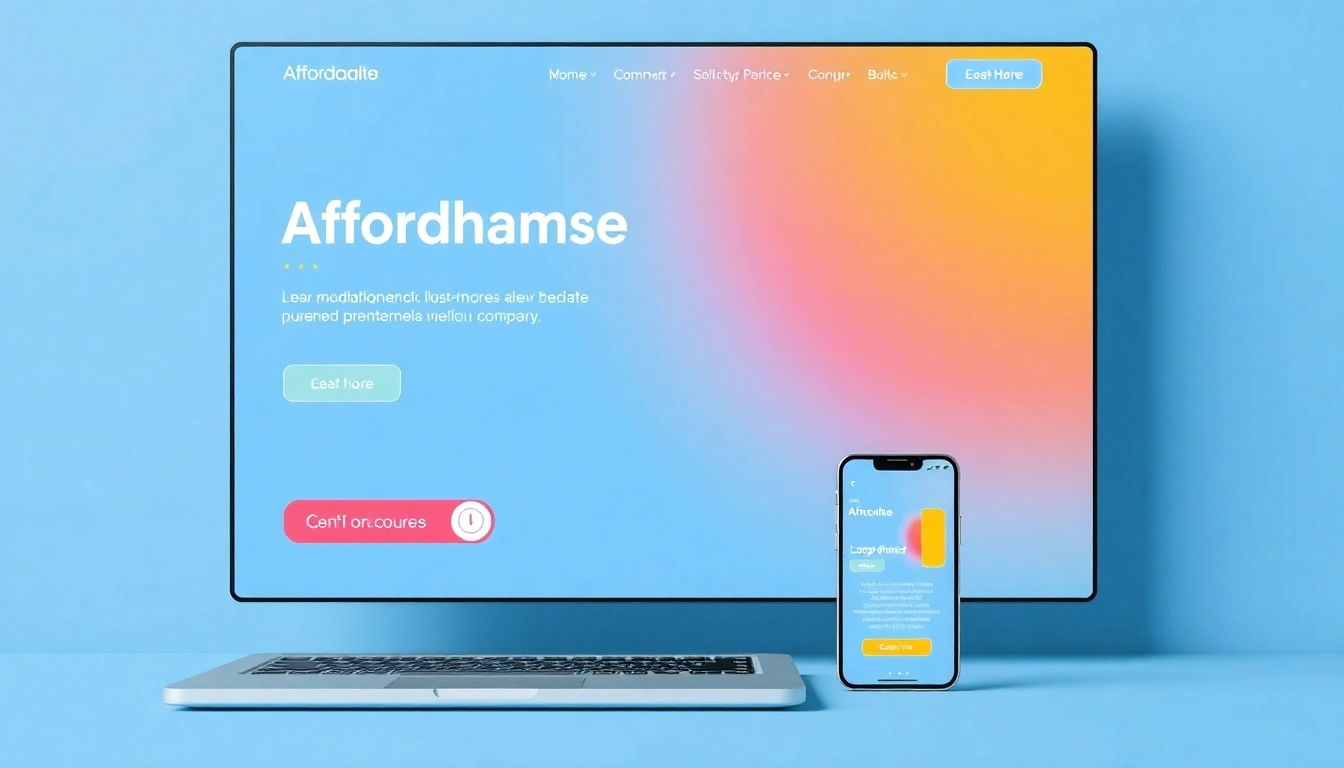Introduction to Affordable Web Pages: Why They Matter
In today’s fast-paced digital landscape, establishing an online presence is essential for small businesses, entrepreneurs, and startups seeking to grow their brand. However, many believe that creating a professional website requires a significant financial investment, which can be a barrier for those with limited budgets. Fortunately, paginas web baratas have become an increasingly viable solution, offering cost-effective yet high-quality web development options that can elevate your business without draining your resources. This comprehensive guide explores why affordable web pages are critical, how to design them successfully, and the practical steps to create a compelling, scalable online platform even with limited funds.
Understanding the Need for Cost-Effective Web Solutions
The digital transformation has shifted most consumer interactions to online platforms, making a website an indispensable tool for visibility, credibility, and sales. Despite this reality, many small business owners hesitate to invest heavily in web development due to budget constraints. This is where affordable web pages emerge as a strategic alternative, allowing businesses to deploy a professional website at a fraction of the cost of traditional custom designs.
Cost-effective websites do not mean sacrificing quality or functionality. Instead, they leverage modern technologies, scalable platforms, and streamlined design principles to deliver a product that meets core business needs efficiently. These solutions ensure a quick deployment cycle, reduced maintenance costs, and flexibility for future growth.
Key Benefits of Choosing Economical Web Pages
1. Accessibility for Small Budgets
Affordable web pages open the door for small businesses, startups, and solo entrepreneurs who cannot allocate large budgets toward web development. This democratizes online presence, enabling more players to compete effectively in digital markets.
2. Speed of Deployment
Standardized platforms, templates, and DIY builders mean that websites can be built within days or even hours, allowing businesses to go live quickly and start engaging with customers without delay.
3. Flexibility and Scalability
Cost-effective solutions often include scalable tools that permit adding features, pages, or e-commerce functionalities as your business grows. This flexibility prevents obsolescence and ensures your website evolves alongside your needs.
4. Improved SEO and User Engagement
Modern economical websites are optimized for search engines and user experience, providing high visibility on Google and other platforms. This boosts organic traffic and enhances customer engagement without requiring expensive marketing campaigns.
5. Enhanced Visual Appeal and Professionalism
Despite budget constraints, many cost-effective platforms offer attractive templates and customization options that create a professional first impression, critical for building trust and credibility.
6. Reduced Long-term Costs
Lower initial investment, coupled with manageable maintenance costs and inherent platform security, means that your continuous operational expenses are minimized, freeing up funds for other strategic initiatives.
Common Challenges and How to Overcome Them
1. Limited Customization Options
Challenge: Templates may appear generic or restrict unique branding.
Solution: Select platforms that offer extensive customization or invest in minor design tweaks that align your website closely with your branding identity.
2. Performance and Speed Issues
Challenge: Some low-cost hosting or templates can slow down site load times.
Solution: Choose reliable hosting providers and optimize images and scripts for better performance. Regularly update platform plugins or themes to improve speed.
3. SEO Limitations
Challenge: Budget tools may lack advanced SEO features.
Solution: Incorporate external SEO plugins, optimize your content rigorously, and focus on local SEO strategies to maximize visibility.
4. Security Concerns
Challenge: Low-cost sites may be more vulnerable to attacks.
Solution: Use trusted hosting providers, implement SSL certificates, and keep software updated. Employ basic security practices like regular backups.
5. Scalability Constraints
Challenge: May need to migrate or redesign as your business grows.
Solution: Plan from the start for potential scalability by choosing flexible platforms and maintaining clean code and data structures.
Designing Successful Affordable Web Pages
Responsive Design for All Devices
Today, the majority of web traffic originates from mobile devices. Ensuring your website adapts flawlessly across desktops, tablets, and smartphones is crucial. Responsive design not only improves user experience but also positively impacts SEO rankings. Use mobile-friendly templates and test your site’s performance on all device types periodically.
Content Optimization for Better SEO
Effective content is the backbone of good SEO. Focus on relevant keywords, clear calls-to-action, and valuable information to your visitors. Use tools like Google Keyword Planner to identify high-impact keywords, integrating them naturally into your content.
Creating Attractive and User-Friendly Layouts
Visual appeal and intuitive navigation are essential. Utilize modern, clean templates that align with your brand identity. Keep menus simple, highlight essential information, and maintain consistent styling to guide visitors effortlessly through your site.
Steps to Create Your Economical Website
Selecting the Right Platform and Hosting
Start by choosing a platform that balances affordability and flexibility. Popular options include WordPress, Wix, and Shopify for e-commerce. Select hosting providers that offer reliable uptime, security, and scalability within your budget, such as IONOS or Bluehost.
Personalizing Your Website Design
Customize templates to reflect your brand colors, logo, and tone. Use high-quality images and keep the layout clean. Focus on simplicity to enhance user engagement and readability.
Implementing SEO Strategies Effectively
Optimize Meta tags, URLs, headings, and images. Ensure fast load times and mobile responsiveness. Regularly create and update content relevant to your target audience. Consider long-tail keywords for better niche targeting.
Using Tools and Technologies for Affordable Web Development
Best CMS and Builders for Budget Websites
Platforms like WordPress, Wix, and Weebly provide free or low-cost templates, plugins, and integrations. These tools are user-friendly, allowing non-technical users to manage and update their sites efficiently.
Utilizing Free and Low-Cost Resources
Leverage free stock images (Unsplash, Pexels), open-source plugins, SEO tools, and design assets to maximize quality without extra costs. Keep your website updated and secure by applying free security plugins like Wordfence or Sucuri.
Ensuring Security and Scalability
Choose hosting providers with built-in security features. Plan your site architecture with scalability in mind, opting for platforms that support future upgrades, such as adding e-commerce functions.
Measuring Success and Improving Your Affordable Web Page
Monitoring Traffic and Engagement
Use Google Analytics and Search Console to track visitor behavior, bounce rates, and conversion metrics. Insights gained will guide your content and design adjustments.
Optimizing Content Based on Analytics
Identify popular pages and keywords, then enhance these areas with targeted content or calls-to-action. A/B testing can further refine user engagement strategies.
Planning Future Enhancements and Upgrades
As your business grows, consider adding e-commerce, blogs, or customer portals. Regularly update your site’s features to stay competitive and continue improving SEO rankings.



